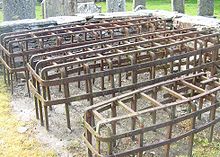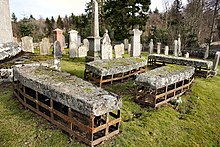Mortsafe
This article includes a list of general references, but it lacks sufficient corresponding inline citations. (October 2012) |

A mortsafe or mortcage was a construction designed to protect graves from disturbance, used in the United Kingdom. Resurrectionists had supplied schools of anatomy since the early 18th century. This was due to the necessity for medical students to learn anatomy by attending dissections of human subjects, which was frustrated by the very limited allowance of dead bodies – for example the corpses of executed criminals – granted by the government, which controlled the supply.[1]
Official inaction
[edit]The British authorities turned a blind eye to grave-rifling because surgeons and students were working to advance medical knowledge. They kept publicity to a minimum to prevent people from realising what was happening. The cases of grave-robbing that came to light caused riots, damage to property and even fatal attacks. In the early 19th century, with the great increase in numbers of schools and students, there was continual rifling of secluded graveyards, fights in city burial grounds and other disturbances.[2]
Men were employed to steal bodies and transport them from place to place, even across the sea, for sale to medical schools. Revelations led to public outrage, particularly in Scotland, where there was great reverence for the dead and belief in the Resurrection. It was popularly believed that the dead could not rise in an incomplete state.[3]
Precautions
[edit]
People were determined to protect the graves of newly deceased friends and relatives. The rich could afford heavy table tombstones, vaults, mausoleums and iron cages around graves. The poor began to place flowers and pebbles on graves to detect disturbances. They dug heather and branches into the soil to make disinterment more difficult. Large stones, often coffin-shaped, sometimes the gift of a wealthy man to the parish, were placed over new graves.
Friends and relatives took turns or hired men to watch graves through the hours of darkness. Watch-houses were sometimes erected to shelter the watchers. One watch-house in Edinburgh is a three-storey castellated building with windows. Watching societies were often formed in towns, one in Glasgow having 2,000 members. Many kirk session houses were used by watchers, but graves were still violated.
Mortsafe
[edit]The mortsafe was invented around 1816. These were iron or iron-and-stone devices of great weight, in many different designs. Often they were complex heavy iron contraptions of rods and plates, padlocked together. Examples have been found close to all Scottish medical schools. A plate was placed over the coffin, and rods with heads were pushed through holes in it. These rods were kept in place by locking a second plate over the first, to form extremely heavy protection. It would be removed by two people with keys.
They were placed over the coffins for about six weeks, then removed for further use when the body inside was sufficiently decayed. There is a model of a mortsafe of this type in Marischal Museum, Aberdeen. Sometimes a church bought them and hired them out. Societies were formed to purchase them and control their use, with annual membership fees, and charges made to non-members.
Vaults and watch-houses
[edit]
Publicity surrounding the crimes of Burke and Hare heightened the fear felt by many people. It was about this time that vaults – repositories for dead bodies – were built by public subscription in Scotland, with their use governed by rules and regulations. Some of these were above ground. Others – mainly in Aberdeenshire – were wholly or partly underground.
In one Aberdeenshire village, Udny Green, the morthouse is a circular building with a thick studded wooden door and an inner iron door. Inside there is a turntable to accommodate seven coffins. A coffin would be moved round as further ones were added. By the time it reappeared, the body would be of no use to the dissectionists.
Likely all communities near the Scottish schools of medicine in Edinburgh, Glasgow and Aberdeen employed some means of protecting the dead. Some used both mortsafes and watching. There are watch-houses in the remoter Scottish areas, in the Borders, and two have been found in the English county of Northumberland.
Surviving examples
[edit]
Surviving mortsafes are generally found in churchyards and burial grounds. Some are very broken and rusting away. One has been restored and hung in a church porch, with an explanatory note, by the East Lothian Antiquary Society. There are one or two in museums, but those on display rarely have any indication of what they are, or how they were used. Some documents relating to mortsafes and other protection devices are in libraries and record offices.[4]
There are two mortsafes in reasonable condition outside the old Aberfoyle church in Stirling, which was 30 miles from the nearest School of Anatomy in Glasgow. One is outside the front door of Skene Parish Church, Kirkton of Skene, Aberdeenshire, in a slightly rusted state. Another in reasonable condition is in the kirkyard at the remote hamlet of Towie, west of Alford. Tullibody has a famous stone coffin, and had an iron coffin case to thwart local body-snatchers.[5]
-
A mortsafe in Greyfriars Kirkyard, Edinburgh
-
A watchhouse and iron mortsafe in Cadder Parish Church near Glasgow
References
[edit]- ^ Holder, Geoff (2010). Scottish Bodysnatchers. Stroud : The History Press. ISBN 978-0-7524-5603-4
- ^ W Roughead, ed., Burke And Hare, Notable British Trials Series, William Hodge and Company Limited 1948, p.3:
- ^ W Roughead, ed., Burke And Hare, Notable British Trials Series, William Hodge and Company Limited 1948, p.3:
- ^ Hallen, A. W. Cornelius (1889). Northern notes and queries or the Scottish antiquary. Vol. 3. Edinburgh: David Douglas. p. 20. Retrieved 8 July 2017.
- ^ Hallen, A. W. Cornelius (1889). Northern notes and queries or the Scottish antiquary. Vol. 3. Edinburgh: David Douglas. p. 20. Retrieved 8 July 2017.


